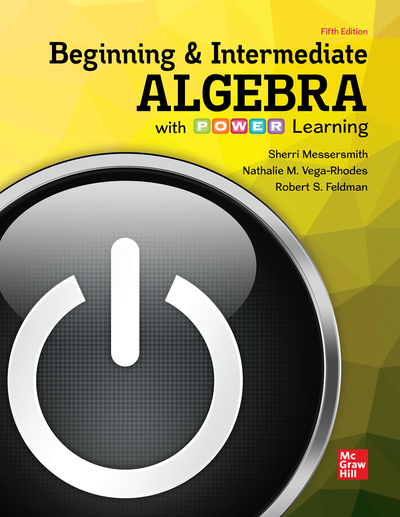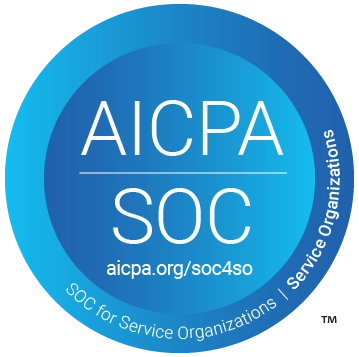Log In to My PreK-12 Platform


Beginning and Intermediate Algebra with P.O.W.E.R. Learning, 5th Edition
Format Options:
-
Lowest Price!
eBook from $59.00 -
Print from $70.00 -
ALEKS from $254.22
McGraw Hill eBook
Textbook Rental (150 Days Access)
- Rent for a fraction of the printed textbook price
- Complete text bound in hardcover or softcover
Loose-Leaf Purchase
Unbound loose-leaf version of full text
Shipping Options
- Standard
- Next-day air
- 2nd-day air
Orders within the United States are shipped via FedEx or UPS Ground. For shipments to locations outside of the U.S., only standard shipping is available. All shipping options assume the product is available and that processing an order takes 24 to 48 hours prior to shipping.
* The estimated amount of time this product will be on the market is based on a number of factors, including faculty input to instructional design and the prior revision cycle and updates to academic research-which typically results in a revision cycle ranging from every two to four years for this product. Pricing subject to change at any time.
Instructor Information
Quick Actions (Only for Validated Instructor Accounts):
The 5th edition of Beginning and Intermediate Algebra by Sherri Messersmith and Nathalie Vega-Rhodes represents the most evolved version of the P.O.W.E.R. series textbooks yet. To each chapter we have added a new Get Ready chapter opener that contains prerequisite/corequisite lessons, with exercises, to prepare students to learn the concepts coming up in the chapter. Also new to this edition are the two academic mindset topics of developing a growth mindset and developing grit. The power (no pun intended) of the Internet is that it allows us to enhance the learning and teaching experience for students and instructors. We can do things that we couldn’t dream of even 10 years ago! That’s where Nathalie Vega-Rhodes comes in. A long-time P.O.W.E.R. math textbook user and outstanding instructor, Nathalie has a lot of experience using digital tools. Better yet, she and Sherri have the same philosophy of teaching, love for students, and belief in addressing all of their students’ needs in the classroom.
What makes P.O.W.E.R. a unique tool for the classroom? A major challenge in developmental courses is that students at this level struggle with basic study skills and habits. Maybe this is one of their first college courses or perhaps they are adults returning to school after a long absence. Either way, many of the individuals taking this course don’t know how to be good students. Instructors often don’t have the time, the resources or the expertise to teach success skills AND the math concepts. The P.O.W.E.R. Learning Framework was developed by successful author, psychologist, student success instructor and researcher, Bob Feldman. It is a method of accomplishing any task using five simple and consistent steps. Prepare. Organize. Work. Evaluate. Rethink. The P.O.W.E.R. framework that Math instructors have come to know and love is at the core of each section and new study strategies and exercises have been integrated with every chapter better help students successfully learn math concepts while at the same time developing habits that will serve them well throughout their college careers and in their daily lives. The conversational writing style, practical applications, innovative student resources and expanded available in ALEKS makes this an appealing and very teachable option for faculty.
About the Author
Sherri Messersmith
Sherri Messersmith has been teaching at College of DuPage in Glen Ellyn, Illinois, since 1994. She has over 25 years of experience teaching many different courses from developmental mathematics through calculus. She earned a bachelor of science degree in the teaching of mathematics at the University of Illinois at Urbana-Champaign and went on to teach at the high level for two years. Sherri returned to UIUC and earned a master of science in applied mathematics and stayed on at the university to teach and coordinate large sections of undergraduate math courses. Sherri has authored several textbook, and she has also appeared in videos accompanying several McGraw-Hill texts.Sherri lives outside of Chicago with her husband, Phil, and their daughters, Alex and Cailen. In her precious free time, she likes to read, play the guitar, and travel -- the manuscripts for this and her previous books have accompanied her from Spain to Greece and many points in between.
Nathalie Vega-Rhodes
Nathalie Vega-Rhodes’ career in higher education began seventeen years ago and has encompassed a number of student-focused positions. For nearly a decade, she has taught mathematics ranging from developmental courses to calculus, as well as student success courses. She holds a Bachelor of Arts in Mathematics from the University of Houston and a Master of Science in Mathematics from the University of Houston—Clear Lake. In addition to teaching, as Mathematics Technology Coordinator at Lone Star College—Kingwood, she assists math faculty with technology-related pedagogical and implementation strategies. Her earliest work in higher education focused on academic support, first as a tutor and supplemental instruction (SI) leader, and then as a coordinator for a math tutoring and SI program. In her free time, Nathalie enjoys scuba diving and traveling with her husband, hanging out with her dog, and reading.
Robert Feldman
Bob Feldman still remembers those moments of being overwhelmed when he started college at Wesleyan University. “I wondered whether I was up to the challenges that faced me,” he recalls, “and—although I never would have admitted it at the time—I really had no idea what it took to be successful at college.”
That experience, along with his encounters with many students during his own teaching career, led to a life-long interest in helping students navigate the critical transition that they face at the start of their own college careers. Professor Feldman, who went on to receive a doctorate in psychology from the University of Wisconsin–Madison, is now Deputy Chancellor and Professor of Psychological and Brain Sciences at the University of Massachusetts Amherst. He is founding director of POWER Up for Student Success, the first-year experience course for incoming students.
Professor Feldman’s proudest professional accomplishment is winning the College Outstanding Teaching Award at UMass. He also has been named a Hewlett Teaching Fellow and was Senior Online Instruction Fellow. He has taught courses at Mount Holyoke College, Wesleyan University, and Virginia Commonwealth University. Professor Feldman is a Fellow of the American Psychological Association, the Association for Psychological Science, and the American Association for the Advancement of Science. He is a winner of a Fulbright Senior Research Scholar and Lecturer award and has written over 200 scientific articles, book chapters, and books. His books, some of which have been translated into Spanish, French, Portuguese, Dutch, Japanese, and Chinese, include Improving the First Year of College: Research and Practice; Understanding Psychology, 12/e; and Development Across the Life Span, 7/e. His research interests encompass the study of honesty and truthfulness in everyday life, development of nonverbal behavior in children, and the social psychology of education. His research has been supported by grants from the National Institute of Mental Health and the National Institute on Disabilities and Rehabilitation Research.
With the last of his three children completing college, Professor Feldman occupies his spare time with pretty decent cooking and earnest, but admittedly unpolished, piano playing. He also loves to travel. He lives with his wife, who is an educational psychologist, in a home overlooking the Holyoke mountain range in western Massachusetts.
Accessibility
Creating accessible products is a priority for McGraw Hill. We make accessibility and adhering to WCAG AA guidelines a part of our day-to-day development efforts and product roadmaps.
For more information, visit our accessibility page, or contact us at accessibility@mheducation.com
Need support? We're here to help - Get real-world support and resources every step of the way.

